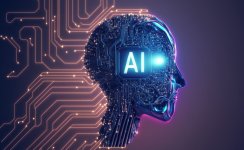AI & Machine Learning: Shaping the World you’re Already Living In
If you’ve ever unlocked your phone using your face, received a movie recommendation you actually liked, or chatted with a virtual assistant online — congratulations, you’ve already interacted with Artificial Intelligence (AI) and Machine Learning (ML). But what exactly are these technologies, and why are they changing the world at such a rapid pace?
Let’s break it down.
What Is Artificial Intelligence?
Artificial Intelligence is a field of computer science that focuses on building systems capable of performing tasks that normally require human intelligence. These tasks include understanding language, recognizing images, making decisions, and even creating art or music.
AI isn’t about robots taking over the world — it’s about machines that can learn, reason, and adapt to make our lives easier.
And What About Machine Learning?
Machine Learning is a subset of AI — think of it as the brain behind the operation. Instead of being programmed with strict rules, ML models are trained using data. They learn patterns, make predictions, and improve over time without being explicitly told what to do.
Here’s a simple example: Imagine teaching a child to identify fruits. You show them several apples and bananas, and eventually, they learn to tell the difference on their own. ML works similarly — it learns from examples, not instructions.
Why It Matters — And Where You See It
AI and ML aren’t just buzzwords; they’re quietly working behind the scenes in ways most of us don’t even notice:
But Isn’t It Dangerous?
It’s true — like all powerful tools, AI comes with risks. Bias in data can lead to unfair outcomes. Automation may affect jobs. And there are ethical concerns about privacy and control. But that’s why AI needs responsible design and human oversight. The focus now is on creating explainable, ethical, and inclusive AI that benefits all.
The Future is Now
AI and ML aren’t part of a distant sci-fi future — they’re already transforming how we live and work. In the coming years, they’ll become even more integrated into every industry, from autonomous cars to climate forecasting.
So, whether you're a student, professional, or entrepreneur, understanding AI and ML isn’t optional anymore — it’s a must. These technologies are shaping our future, and the more we know about them, the better we can leverage them to solve real-world problems.
AI and ML aren’t here to replace humans — they’re here to empower us. By embracing this technological shift with awareness and responsibility, we can create a smarter, more inclusive, and more innovative world.
If you’ve ever unlocked your phone using your face, received a movie recommendation you actually liked, or chatted with a virtual assistant online — congratulations, you’ve already interacted with Artificial Intelligence (AI) and Machine Learning (ML). But what exactly are these technologies, and why are they changing the world at such a rapid pace?
Let’s break it down.
What Is Artificial Intelligence?
Artificial Intelligence is a field of computer science that focuses on building systems capable of performing tasks that normally require human intelligence. These tasks include understanding language, recognizing images, making decisions, and even creating art or music.
AI isn’t about robots taking over the world — it’s about machines that can learn, reason, and adapt to make our lives easier.
And What About Machine Learning?
Machine Learning is a subset of AI — think of it as the brain behind the operation. Instead of being programmed with strict rules, ML models are trained using data. They learn patterns, make predictions, and improve over time without being explicitly told what to do.
Here’s a simple example: Imagine teaching a child to identify fruits. You show them several apples and bananas, and eventually, they learn to tell the difference on their own. ML works similarly — it learns from examples, not instructions.
Why It Matters — And Where You See It
AI and ML aren’t just buzzwords; they’re quietly working behind the scenes in ways most of us don’t even notice:
- Healthcare: AI helps detect diseases early through image recognition and patient data analysis. It’s even assisting in drug discovery.
- Banking & Finance: Fraud detection systems use ML to monitor millions of transactions and flag suspicious activity instantly.
- Retail & E-Commerce: Personalized shopping recommendations, chatbots for customer support, and dynamic pricing all use AI.
- Agriculture: Smart drones and sensors use ML to detect crop diseases, optimize irrigation, and improve yield.
- Education: AI-driven platforms adapt learning paths for each student based on their performance, creating more effective and personalized learning.
But Isn’t It Dangerous?
It’s true — like all powerful tools, AI comes with risks. Bias in data can lead to unfair outcomes. Automation may affect jobs. And there are ethical concerns about privacy and control. But that’s why AI needs responsible design and human oversight. The focus now is on creating explainable, ethical, and inclusive AI that benefits all.
The Future is Now
AI and ML aren’t part of a distant sci-fi future — they’re already transforming how we live and work. In the coming years, they’ll become even more integrated into every industry, from autonomous cars to climate forecasting.
So, whether you're a student, professional, or entrepreneur, understanding AI and ML isn’t optional anymore — it’s a must. These technologies are shaping our future, and the more we know about them, the better we can leverage them to solve real-world problems.
AI and ML aren’t here to replace humans — they’re here to empower us. By embracing this technological shift with awareness and responsibility, we can create a smarter, more inclusive, and more innovative world.

